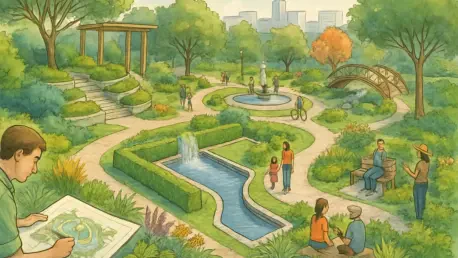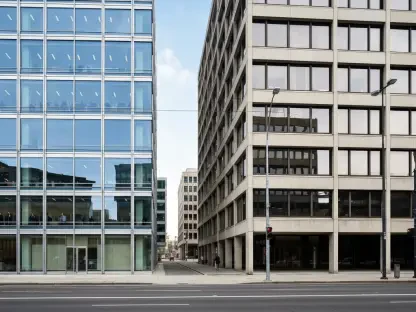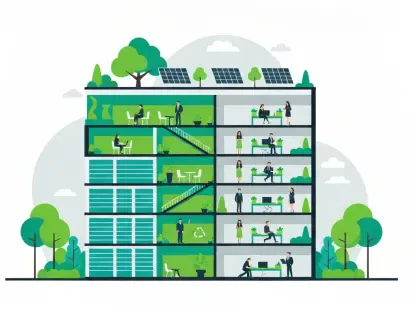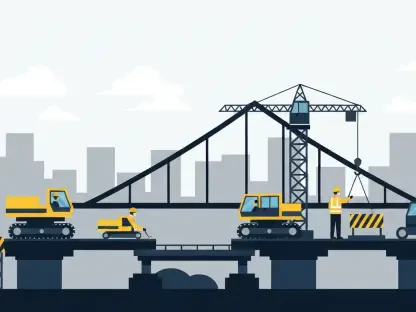Imagine stepping into a theme park where every path, tree, and open space feels like part of a larger story, guiding emotions and creating memories that linger long after the visit ends. Landscape architecture, often an unseen force, is the mastermind behind these transformative environments, crafting spaces that resonate on a deeply human level. Far from being mere decoration, it blends art, science, and functionality to shape how people interact with places like resorts, cultural hubs, and public plazas. Through the expert insights of Storyland Studios and Rob Moffat, a veteran in the field with over 25 years of experience, the profound impact of this discipline comes into focus. Moffat, a former Disney Imagineer, reveals how landscapes are not just backgrounds but active participants in storytelling. This exploration uncovers the subtle yet powerful ways landscape architecture turns ordinary spaces into extraordinary experiences, inviting a closer look at the environments that surround and inspire daily life.
Crafting Emotional Connections
Landscape architecture holds a unique power to influence how spaces are perceived and remembered, acting as a silent force in shaping guest experiences. At the heart of this process lies the ability to evoke emotions—whether it’s the thrill of adventure in a theme park or the serenity of a resort garden. According to insights from Storyland Studios, led by industry expert Rob Moffat, every interaction with a designed space contributes to a broader narrative. A well-planned landscape can make visitors feel welcomed, intrigued, or even transported to another world, encouraging them to return time and again. This emotional resonance isn’t accidental; it’s the result of deliberate design choices that consider how people move through and connect with their surroundings. From the texture of a pathway to the placement of shaded seating, each element plays a role in creating a lasting impression. The ultimate goal is to ensure that a space isn’t just seen but truly felt, leaving an indelible mark on those who experience it.
Beyond evoking emotion, landscape architecture focuses on enhancing the functionality of a space to support memorable moments. Moffat emphasizes that a successful design anticipates the needs of guests, whether they’re navigating a crowded festival or seeking a quiet corner for reflection. This requires a deep understanding of human behavior and spatial dynamics, ensuring that environments are intuitive and inviting. For instance, a winding path might slow down foot traffic to encourage exploration, while open areas can foster a sense of community during events. Such thoughtful planning transforms a visit into an experience, where every step feels purposeful and engaging. This balance of aesthetics and practicality is what sets exceptional landscape design apart, making spaces not only beautiful but also deeply usable. By prioritizing the guest journey, landscape architects create environments that resonate on both an emotional and practical level, turning fleeting visits into cherished memories that endure.
Fostering Seamless Collaboration
One of the most critical aspects of landscape architecture is its role as a unifying force among diverse design disciplines. It acts as a bridge, connecting architecture, engineering, and other fields to create a harmonious whole. Insights from Storyland Studios highlight that the most impactful designs emerge when landscape elements are integrated early in the planning process, rather than treated as an afterthought. Rob Moffat notes that collaboration ensures buildings and outdoor spaces complement each other, resulting in environments that feel cohesive and intentional. This interdisciplinary approach addresses practical challenges like circulation and safety while maintaining a strong creative vision. When all elements work in tandem, the result is a space that feels effortless to navigate, yet rich in detail and purpose. This synergy is essential for crafting experiences that captivate and function seamlessly, proving that teamwork is at the core of transformative design.
Collaboration in landscape architecture also extends to solving complex site-specific issues that can impact the overall experience. Whether dealing with uneven terrain, environmental constraints, or urban density, landscape architects must adapt their designs to fit the unique characteristics of each location. Moffat underscores the importance of working closely with other professionals to anticipate potential obstacles, ensuring that solutions enhance rather than detract from the intended atmosphere. For example, integrating natural features like existing trees or water bodies can add authenticity to a space, while also addressing ecological concerns. This problem-solving mindset requires flexibility and innovation, balancing the needs of the project with the limitations of the site. By fostering open communication among teams, landscape architecture becomes a catalyst for creating spaces that are not only visually stunning but also practical and resilient, enriching the visitor experience through thoughtful, collaborative design.
Embracing Sustainability with Innovation
Sustainability has become a cornerstone of modern landscape architecture, pushing designers to think beyond aesthetics and into the realm of environmental responsibility. Storyland Studios, guided by Rob Moffat’s expertise, champions the idea that sustainable design isn’t just about meeting regulations—it’s about finding creative ways to enhance the natural world. Strategies like water conservation, promoting biodiversity, and using plants for natural shade are integral to this approach. These efforts ensure that spaces remain viable for future generations while offering immediate benefits like reduced maintenance costs and improved guest comfort. However, achieving these goals often involves navigating challenges such as limited budgets or previously developed sites. By prioritizing eco-friendly solutions, landscape architects contribute to a broader movement of environmental stewardship, proving that beauty and responsibility can coexist in design.
Educating clients on the value of sustainable practices is another vital aspect of this field, as highlighted by Moffat’s insights. Many stakeholders may initially view sustainability as a constraint rather than an opportunity, focusing on short-term costs over long-term gains. Landscape architects often take on the role of advocates, demonstrating how green initiatives can enhance a space’s appeal while aligning with broader ecological goals. For instance, incorporating native plants not only reduces water usage but also creates a sense of place that resonates with visitors. This educational process requires patience and clear communication, helping clients see the tangible benefits of such choices. Through this advocacy, sustainability transforms from a regulatory burden into a design strength, enriching spaces with purpose and foresight. The result is an environment that serves both people and the planet, fostering experiences that are as meaningful as they are memorable.
Blending Artistry with Technical Precision
Landscape architecture is often misunderstood as a purely decorative field, but its true depth lies in the intricate balance of creativity and technical skill. Rob Moffat, drawing from decades of experience with Storyland Studios, dispels the myth that the discipline is simply about adding greenery. Instead, it involves complex problem-solving to ensure spaces are both functional and inspiring. Tools like 3D modeling software, such as Revit, play a crucial role in this process by allowing designers to visualize potential issues before construction begins. This foresight minimizes costly errors and ensures that every element, from pathways to plant placement, serves a specific purpose. The technical rigor behind these designs underscores the profession’s dual nature, where artistic vision must align with practical execution to create environments that captivate and endure.
This technical precision also enhances the ability to tailor designs to specific experiential goals, ensuring that every detail contributes to the overall impact. Moffat points out that landscape architects must anticipate how spaces will be used under varying conditions, whether during peak visitor hours or different seasons. For example, a plaza might need to accommodate large crowds for events while still offering intimate areas for quiet moments. Achieving this balance requires meticulous planning and a deep understanding of spatial dynamics, often supported by advanced design technologies. These tools enable early identification of challenges, such as drainage issues or accessibility concerns, allowing for solutions that seamlessly integrate with the aesthetic vision. By merging artistry with such analytical approaches, landscape architecture creates spaces that not only look stunning but also function flawlessly, delivering experiences that feel both magical and effortless to those who inhabit them.
Evolving Trends in Experiential Design
The field of landscape architecture is undergoing a significant shift, with growing recognition of its role as a foundational element in experiential design. No longer viewed as a mere finishing touch, landscapes are now seen as essential to storytelling and emotional engagement in spaces like theme parks and urban centers. Storyland Studios, through Rob Moffat’s perspective, notes that this change reflects a broader industry trend toward holistic design, where every component contributes to a unified narrative. Alongside this, there’s an increasing emphasis on sustainable practices, driven by both environmental necessity and client expectations. The adoption of cutting-edge technologies further supports this evolution, enabling more accurate and efficient design processes. These trends signal a future where landscape architecture plays an even more central role in shaping how spaces are experienced, blending innovation with human connection.
Another key trend is the rising demand for adaptability in designed environments, responding to diverse and changing user needs. Moffat highlights that modern landscapes must serve multiple functions, transforming seamlessly from day to night or across seasons. This flexibility ensures that spaces remain relevant and engaging over time, catering to a wide range of activities and demographics. For instance, a public plaza might host morning fitness classes and evening concerts, each requiring different spatial configurations. Designing for such versatility demands foresight and a commitment to creating dynamic environments that evolve with their users. As the industry continues to prioritize these adaptable, inclusive approaches, landscape architecture stands at the forefront of redefining how spaces are used and remembered, ensuring they remain vibrant hubs of activity and inspiration for all who visit.
Showcasing Transformative Projects
A vivid illustration of landscape architecture’s impact can be seen in Storyland Studios’ work on Trilith Live in Atlanta, slated to open in 2026. This project transforms a plaza into a multifunctional urban park, featuring glowing aggregate paving that creates a captivating nighttime ambiance. Thoughtfully sculpted mounds offer casual seating and frame performance areas, while flexible spaces accommodate diverse events like yoga sessions or live concerts. Rob Moffat’s enthusiasm for the project’s adaptability—shifting seamlessly with the time of day and seasons—underscores the intentional design behind every element. This space not only enhances the surrounding entertainment venues but also fosters community connection, proving how landscape architecture can elevate everyday interactions into extraordinary moments. Such projects highlight the discipline’s ability to blend utility with enchantment, creating lasting impressions through innovative design.
The broader implications of such initiatives reveal the expansive potential of landscape architecture to redefine various environments. Beyond theme parks and entertainment hubs, the principles applied in projects like Trilith Live can influence community spaces and regional attractions. Storyland Studios’ ambitions, including ventures like LIBERTYLAND near Mount Rushmore, suggest a commitment to applying these concepts across diverse contexts. While specifics on such projects remain limited, they point to a future where landscapes play a pivotal role in economic and cultural vitality, transforming how people engage with their surroundings. These real-world applications demonstrate that well-designed outdoor spaces can serve as catalysts for connection and inspiration, reinforcing the idea that landscape architecture is a powerful tool for shaping not just physical environments but also the human experiences within them.
Reflecting on Lasting Impacts
Looking back, the journey through the insights of Storyland Studios and Rob Moffat paints a vivid picture of landscape architecture as an indispensable force in experiential design. It weaves together emotion, functionality, and sustainability, crafting spaces that leave deep impressions on visitors. Projects like Trilith Live stand as testaments to how thoughtful landscapes elevate ordinary moments into cherished memories, balancing practicality with artistry. As the field progresses, the emphasis on collaboration and innovation paves the way for environments that are both beautiful and enduring. Moving forward, the challenge lies in continuing to advocate for sustainable practices and adaptable designs that meet evolving needs. Embracing advanced tools and fostering interdisciplinary partnerships will be key to pushing the boundaries of what landscapes can achieve. Ultimately, the legacy of this discipline rests in its ability to create spaces that resonate across generations, inviting all to experience the world in new, unforgettable ways.









